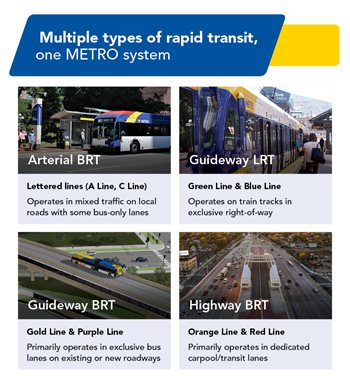Why was LRT chosen for this corridor?
Many residents have asked why light rail was chosen for this line instead of bus rapid transit or another mode. It’s an important question with many considerations.
 Project partners, including Hennepin County, the Metropolitan Council, the Federal Transit Administration, and corridor cities, analyzed a total of 9 light rail transit (LRT) and 12 bus rapid transit (BRT) route alternatives for this corridor. Both LRT and different varieties of BRT work together to efficiently move transit customers in our high-frequency rapid transit system. The graphic below illustrates some of the features of each. Ultimately, LRT was recommended for this corridor over BRT because of BRT’s lower estimated ridership and requirement to transfer, limited vehicle capacity, fewer passengers per revenue hour, and greater impact to general roadway traffic compared to LRT.
Project partners, including Hennepin County, the Metropolitan Council, the Federal Transit Administration, and corridor cities, analyzed a total of 9 light rail transit (LRT) and 12 bus rapid transit (BRT) route alternatives for this corridor. Both LRT and different varieties of BRT work together to efficiently move transit customers in our high-frequency rapid transit system. The graphic below illustrates some of the features of each. Ultimately, LRT was recommended for this corridor over BRT because of BRT’s lower estimated ridership and requirement to transfer, limited vehicle capacity, fewer passengers per revenue hour, and greater impact to general roadway traffic compared to LRT.
Light rail is the right service for this community for many reasons, which were reaffirmed by the Corridor Management Committee in 2021 and by decision-making bodies at multiple points throughout the project’s history.
Key Considerations
LRT and BRT are both crucial parts of our transit system and serve different purposes
A successful transit system needs multiple modes working together to get people where they need to go. LRT and BRT serve different purposes and work together with local bus routes, roads, bikeways, and sidewalks to help everyone move freely in our communities.
Light rail serves as the backbone or main arteries of our transit system. It moves more people and connects major destinations, while feeding other key transit connections like BRT and local bus.
BLE is the missing northern leg of our light rail network
When complete, the Blue Line Extension will be the critical northern segment of our light rail network. From Target Field Station, the Green Line serves communities to the east, the existing Blue Line connects communities to the south, the Green Line Extension will extend light rail to the west, and the Blue Line extension will be the missing northern leg of the light rail network.
This project is an extension of the existing Blue Line
Providing a one-seat ride between corridor cities, downtown Minneapolis, the Mall of America, Minneapolis St. Paul International Airport, and the countless key education, healthcare, employment, and entertainment destinations along the way is of great value to corridor residents and all transit riders. Being able to get to any of the major destinations along the existing Green Line and Green Line Extension as well as the many rapid and local bus lines that connect with the BLE with just one transfer will open many new opportunities to efficiently connect people to the places they need to go.
This corridor relies on transit and deserves investment
The diverse communities along the BLE route have some of the highest transit ridership rates in the state. It includes areas where many households do not have reliable access to a car and depend on transit to meet daily needs. Some of these communities have high rates of poverty and have been historically underserved and underinvested in. They continue to experience the effects of historic systemic racism and discriminatory land use policies like red lining.
A change from LRT to BRT would mean starting over
This project is in the federal Capital Improvement Grants (CIG) program as a light rail project. Changing the mode would mean starting over, being removed from the CIG program, and risking being denied reentry as a BRT project. A mode switch now, would likely mean delaying the timeline for delivering rapid transit service to this corridor many years. Hennepin County has also committed to funding the local share for this light rail project. It is not clear this funding would be available if the project were to change modes.
Other considerations
Cost, travel time, ridership capacity, and right-of-way requirements
Operating capacity
-
LRT’s operating capacity is about three times greater than BRT
-
A typical Metro Transit three-car light rail train has capacity for 198 people
-
A typical Metro Transit 60-foot bus has capacity for 77 people
- Assuming both are in dedicated guideway, it would require 2.5 times as many BRT vehicles and operators (a significant operational cost) to provide the same level of ridership capacity per hour as LRT.
Operating costs
Transit Oriented Development
-
A 2016 study by the University of Minnesota Center for Transportation Studies found a significant impact on job growth for LRT station areas compared to Arterial BRT station areas, showing a clear pattern between a fixed guideway and no guideway
-
LRT is best suited to meet increasing demand as development along the transitway increases over the next 10 to 20 years. Capacity can be added more efficiently, with one or two more trains per hour than with one or two more buses
- LRT has the greater ridership potential to reduce regional Vehicle Miles Traveled (VMT).
Carbon emissions